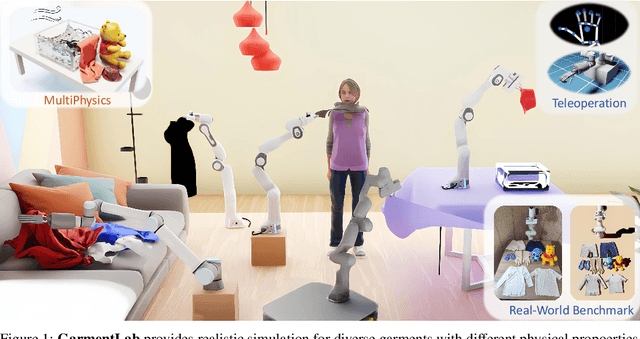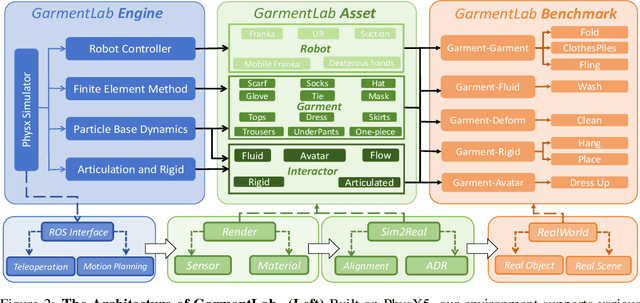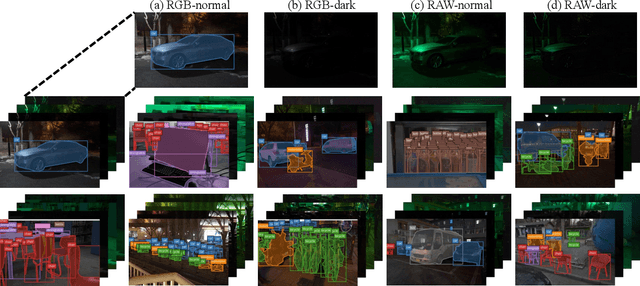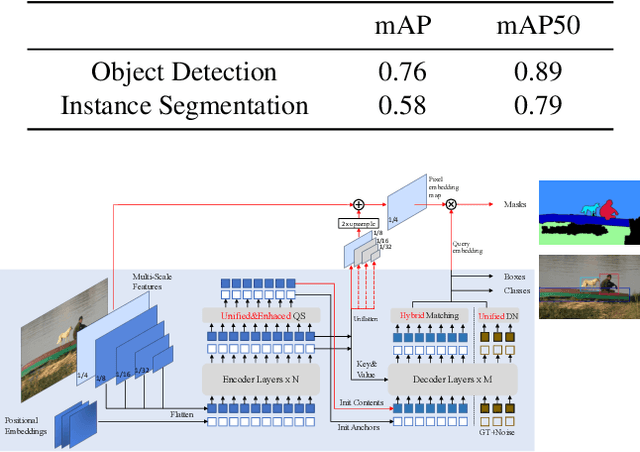Yuanpei Chen
Dexterous Non-Prehensile Manipulation for Ungraspable Object via Extrinsic Dexterity
Mar 29, 2025Abstract:Objects with large base areas become ungraspable when they exceed the end-effector's maximum aperture. Existing approaches address this limitation through extrinsic dexterity, which exploits environmental features for non-prehensile manipulation. While grippers have shown some success in this domain, dexterous hands offer superior flexibility and manipulation capabilities that enable richer environmental interactions, though they present greater control challenges. Here we present ExDex, a dexterous arm-hand system that leverages reinforcement learning to enable non-prehensile manipulation for grasping ungraspable objects. Our system learns two strategic manipulation sequences: relocating objects from table centers to edges for direct grasping, or to walls where extrinsic dexterity enables grasping through environmental interaction. We validate our approach through extensive experiments with dozens of diverse household objects, demonstrating both superior performance and generalization capabilities with novel objects. Furthermore, we successfully transfer the learned policies from simulation to a real-world robot system without additional training, further demonstrating its applicability in real-world scenarios. Project website: https://tangty11.github.io/ExDex/.
SafeVLA: Towards Safety Alignment of Vision-Language-Action Model via Safe Reinforcement Learning
Mar 05, 2025Abstract:Vision-language-action models (VLAs) have shown great potential as generalist robot policies. However, these models pose urgent safety challenges during deployment, including the risk of physical harm to the environment, the robot itself, and humans. How can safety be explicitly incorporated into VLAs? In this work, we propose SafeVLA, a novel algorithm designed to integrate safety into VLAs, ensuring the protection of the environment, robot hardware and humans in real-world settings. SafeVLA effectively balances safety and task performance by employing large-scale constrained learning within simulated environments. We demonstrate that SafeVLA outperforms the current state-of-the-art method in both safety and task performance, achieving average improvements of 83.58% and 3.85%, respectively, in simulation. By prioritizing safety, our approach eliminates high-risk behaviors and reduces the upper bound of unsafe behaviors to 1/35 of that in the current state-of-the-art, thereby significantly mitigating long-tail risks. Furthermore, the learned safety constraints generalize to diverse, unseen scenarios, including multiple out-of-distribution perturbations and tasks. Our data, models and newly proposed benchmark environment are available at https://sites.google.com/view/pku-safevla.
DexGraspVLA: A Vision-Language-Action Framework Towards General Dexterous Grasping
Feb 28, 2025Abstract:Dexterous grasping remains a fundamental yet challenging problem in robotics. A general-purpose robot must be capable of grasping diverse objects in arbitrary scenarios. However, existing research typically relies on specific assumptions, such as single-object settings or limited environments, leading to constrained generalization. Our solution is DexGraspVLA, a hierarchical framework that utilizes a pre-trained Vision-Language model as the high-level task planner and learns a diffusion-based policy as the low-level Action controller. The key insight lies in iteratively transforming diverse language and visual inputs into domain-invariant representations, where imitation learning can be effectively applied due to the alleviation of domain shift. Thus, it enables robust generalization across a wide range of real-world scenarios. Notably, our method achieves a 90+% success rate under thousands of unseen object, lighting, and background combinations in a ``zero-shot'' environment. Empirical analysis further confirms the consistency of internal model behavior across environmental variations, thereby validating our design and explaining its generalization performance. We hope our work can be a step forward in achieving general dexterous grasping. Our demo and code can be found at https://dexgraspvla.github.io/.
Retrieval Dexterity: Efficient Object Retrieval in Clutters with Dexterous Hand
Feb 26, 2025Abstract:Retrieving objects buried beneath multiple objects is not only challenging but also time-consuming. Performing manipulation in such environments presents significant difficulty due to complex contact relationships. Existing methods typically address this task by sequentially grasping and removing each occluding object, resulting in lengthy execution times and requiring impractical grasping capabilities for every occluding object. In this paper, we present a dexterous arm-hand system for efficient object retrieval in multi-object stacked environments. Our approach leverages large-scale parallel reinforcement learning within diverse and carefully designed cluttered environments to train policies. These policies demonstrate emergent manipulation skills (e.g., pushing, stirring, and poking) that efficiently clear occluding objects to expose sufficient surface area of the target object. We conduct extensive evaluations across a set of over 10 household objects in diverse clutter configurations, demonstrating superior retrieval performance and efficiency for both trained and unseen objects. Furthermore, we successfully transfer the learned policies to a real-world dexterous multi-fingered robot system, validating their practical applicability in real-world scenarios. Videos can be found on our project website https://ChangWinde.github.io/RetrDex.
Object-Centric Dexterous Manipulation from Human Motion Data
Nov 06, 2024



Abstract:Manipulating objects to achieve desired goal states is a basic but important skill for dexterous manipulation. Human hand motions demonstrate proficient manipulation capability, providing valuable data for training robots with multi-finger hands. Despite this potential, substantial challenges arise due to the embodiment gap between human and robot hands. In this work, we introduce a hierarchical policy learning framework that uses human hand motion data for training object-centric dexterous robot manipulation. At the core of our method is a high-level trajectory generative model, learned with a large-scale human hand motion capture dataset, to synthesize human-like wrist motions conditioned on the desired object goal states. Guided by the generated wrist motions, deep reinforcement learning is further used to train a low-level finger controller that is grounded in the robot's embodiment to physically interact with the object to achieve the goal. Through extensive evaluation across 10 household objects, our approach not only demonstrates superior performance but also showcases generalization capability to novel object geometries and goal states. Furthermore, we transfer the learned policies from simulation to a real-world bimanual dexterous robot system, further demonstrating its applicability in real-world scenarios. Project website: https://cypypccpy.github.io/obj-dex.github.io/.
GarmentLab: A Unified Simulation and Benchmark for Garment Manipulation
Nov 02, 2024



Abstract:Manipulating garments and fabrics has long been a critical endeavor in the development of home-assistant robots. However, due to complex dynamics and topological structures, garment manipulations pose significant challenges. Recent successes in reinforcement learning and vision-based methods offer promising avenues for learning garment manipulation. Nevertheless, these approaches are severely constrained by current benchmarks, which offer limited diversity of tasks and unrealistic simulation behavior. Therefore, we present GarmentLab, a content-rich benchmark and realistic simulation designed for deformable object and garment manipulation. Our benchmark encompasses a diverse range of garment types, robotic systems and manipulators. The abundant tasks in the benchmark further explores of the interactions between garments, deformable objects, rigid bodies, fluids, and human body. Moreover, by incorporating multiple simulation methods such as FEM and PBD, along with our proposed sim-to-real algorithms and real-world benchmark, we aim to significantly narrow the sim-to-real gap. We evaluate state-of-the-art vision methods, reinforcement learning, and imitation learning approaches on these tasks, highlighting the challenges faced by current algorithms, notably their limited generalization capabilities. Our proposed open-source environments and comprehensive analysis show promising boost to future research in garment manipulation by unlocking the full potential of these methods. We guarantee that we will open-source our code as soon as possible. You can watch the videos in supplementary files to learn more about the details of our work. Our project page is available at: https://garmentlab.github.io/
Neural Attention Field: Emerging Point Relevance in 3D Scenes for One-Shot Dexterous Grasping
Oct 30, 2024



Abstract:One-shot transfer of dexterous grasps to novel scenes with object and context variations has been a challenging problem. While distilled feature fields from large vision models have enabled semantic correspondences across 3D scenes, their features are point-based and restricted to object surfaces, limiting their capability of modeling complex semantic feature distributions for hand-object interactions. In this work, we propose the \textit{neural attention field} for representing semantic-aware dense feature fields in the 3D space by modeling inter-point relevance instead of individual point features. Core to it is a transformer decoder that computes the cross-attention between any 3D query point with all the scene points, and provides the query point feature with an attention-based aggregation. We further propose a self-supervised framework for training the transformer decoder from only a few 3D pointclouds without hand demonstrations. Post-training, the attention field can be applied to novel scenes for semantics-aware dexterous grasping from one-shot demonstration. Experiments show that our method provides better optimization landscapes by encouraging the end-effector to focus on task-relevant scene regions, resulting in significant improvements in success rates on real robots compared with the feature-field-based methods.
Learning to Manipulate Anywhere: A Visual Generalizable Framework For Reinforcement Learning
Jul 22, 2024Abstract:Can we endow visuomotor robots with generalization capabilities to operate in diverse open-world scenarios? In this paper, we propose \textbf{Maniwhere}, a generalizable framework tailored for visual reinforcement learning, enabling the trained robot policies to generalize across a combination of multiple visual disturbance types. Specifically, we introduce a multi-view representation learning approach fused with Spatial Transformer Network (STN) module to capture shared semantic information and correspondences among different viewpoints. In addition, we employ a curriculum-based randomization and augmentation approach to stabilize the RL training process and strengthen the visual generalization ability. To exhibit the effectiveness of Maniwhere, we meticulously design 8 tasks encompassing articulate objects, bi-manual, and dexterous hand manipulation tasks, demonstrating Maniwhere's strong visual generalization and sim2real transfer abilities across 3 hardware platforms. Our experiments show that Maniwhere significantly outperforms existing state-of-the-art methods. Videos are provided at https://gemcollector.github.io/maniwhere/.
Technique Report of CVPR 2024 PBDL Challenges
Jun 15, 2024



Abstract:The intersection of physics-based vision and deep learning presents an exciting frontier for advancing computer vision technologies. By leveraging the principles of physics to inform and enhance deep learning models, we can develop more robust and accurate vision systems. Physics-based vision aims to invert the processes to recover scene properties such as shape, reflectance, light distribution, and medium properties from images. In recent years, deep learning has shown promising improvements for various vision tasks, and when combined with physics-based vision, these approaches can enhance the robustness and accuracy of vision systems. This technical report summarizes the outcomes of the Physics-Based Vision Meets Deep Learning (PBDL) 2024 challenge, held in CVPR 2024 workshop. The challenge consisted of eight tracks, focusing on Low-Light Enhancement and Detection as well as High Dynamic Range (HDR) Imaging. This report details the objectives, methodologies, and results of each track, highlighting the top-performing solutions and their innovative approaches.
Take A Shortcut Back: Mitigating the Gradient Vanishing for Training Spiking Neural Networks
Jan 09, 2024Abstract:The Spiking Neural Network (SNN) is a biologically inspired neural network infrastructure that has recently garnered significant attention. It utilizes binary spike activations to transmit information, thereby replacing multiplications with additions and resulting in high energy efficiency. However, training an SNN directly poses a challenge due to the undefined gradient of the firing spike process. Although prior works have employed various surrogate gradient training methods that use an alternative function to replace the firing process during back-propagation, these approaches ignore an intrinsic problem: gradient vanishing. To address this issue, we propose a shortcut back-propagation method in our paper, which advocates for transmitting the gradient directly from the loss to the shallow layers. This enables us to present the gradient to the shallow layers directly, thereby significantly mitigating the gradient vanishing problem. Additionally, this method does not introduce any burden during the inference phase. To strike a balance between final accuracy and ease of training, we also propose an evolutionary training framework and implement it by inducing a balance coefficient that dynamically changes with the training epoch, which further improves the network's performance. Extensive experiments conducted over static and dynamic datasets using several popular network structures reveal that our method consistently outperforms state-of-the-art methods.
 Add to Chrome
Add to Chrome Add to Firefox
Add to Firefox Add to Edge
Add to Edge